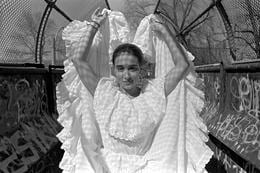Why I Do Not Like Tango
My dislike for tango comes from early childhood experiences. On television, those angry lyrics articulated by glowering faces —caught up close by cameras which were enamored of mere propinquity—became the marks of a ressentiment that I was not yet able to decode, but which reached me with its primal rage. As I began to understand the lyrics that went along with such displays of violent emotion, I had to learn the meaning of words like “percanta,” “bacana,” “pinta brava,” “pelandruna,” “cambalache,” “pebeta,” “flor de fango,” “mishé” or “cotorro.” And even though over the years I have become quite literate in my country’s lunfardo, the resonance of those gestures and those word clusters remains disturbing.
Why? Because of a prevalent misogyny—the mere acting out of a profound anxiety about masculinity that is expressed in many (admittedly not all) tango lyrics. In this sense, tango and ressentiment dance to the same tune: a sense of failure or inferiority is transferred to the “mina,” to the “percanta,” to the “milonguera.” A significant majority of the lyrics in tango produce a vraisemblance in which the male subject recognizes himself through a double move: first incarnating victimhood, and then transforming victimhood as an effective model for authority: the man who sings and complains is the most highly valued speaker. For him, life is unfair. But, much more importantly, that sense of unfairness is tangled up with women’s betrayal. A “mishé” or a “cafisho” offers the triangulation that energizes the competitive tension between men. In an early tango of 1917, recorded by Carlos Gardel, “Mi noche triste,” the ailing male interpellates the cruel female:
Percanta que me amuraste
En lo major de mi vida
Dejándome el alma herida
Y espinas en el corazón
This early tango is gentler than most: here what the abandoned male misses the most is the absence of domestic care: his place is “desarreglado, todo triste, abandonado.” But later tangos are less generous in their longing: a 1921 tango also recorded by Gardel, “Margot”, lashes against the “pelandruna abacanada:”
¡Berretines de bacana que tenías en la mente
Desde el día en que un magnate cajetilla te afiló!
To make matters worse, this false “bacana” keeps her mother in the “conventillo” as a washer-woman, betraying the essential bond of filiation.
Tango lyrics evoke a representational system within which the speaking subject’s impaired masculinity is as scarred by lack as by female abandonment. The Law of the Father is experienced as the externalized displacement of male castration onto the female subject. No strong patriarchal figures are there to provide a semblance of strength: other males appear mostly to undermine any possible mastery. Misogyny manages the ideological crisis: a “presumida” has been lured away by a richer man. Eventually, of course, she will be abandoned. With too few exceptions, tango lyrics go for the triangulation of desire: the other man (a “bacán” –wealthy man—or, much worse, a “cafishio” –pimp) and the lyrical voice are bound together in a competitive drive for the woman. The bond that links the two rivals, as Eve Sedgwick has shown, is as potent—or perhaps, more potent than—the bond with the fickle woman.
Of course, it is only fair to avow that tango lyrics fully express the disenchantment of a population whose dreams of economic and political success were never realized. Leave it to Enrique Discepolo’s “Cambalache” (written in 1935, at the height of the “Década infame”) to convey the radical disenchantment of those who feel cheated by life:
Que el mundo fue y sera una porquería,
Ya lo sé…
Vivimos revolcaos en un merengue
Y en el mismo lodo
Todos manoseaos…
To voice the collective disgust, the man as authoritative speaker tells tales of victimization: self pity validates his voice. Women are rarely given that kind of legitimacy. Even when they seem to make it, as did, among others, Amelita Baltar and Sandra Luna, they are often saddled with words which obliterate the mark of a woman. In 2004, Sandra Luna said it all: tango was born of a god who is “varón y compadrón.”
Related Articles
Disruption in the Immigrant Experience: Colombian Youth Dance Their Way to Continuity
Imagine you are fifteen years old. As an immigrant who has lived in the United States for a few years, you are still trying to find your place. You decide to join a group that dances the traditional dances of your country. You practice every week on Fridays, when you could be going to the movies or hanging out with your friends. Your goal is to perform in that big annual show a lot of people have told you about. That day has finally …
Review of Connecting Lines: New Poetry from Mexico
Lou Dobbs and other talk show hosts want us to believe that a so-called Mexican invasion is denying “true” Americans their jobs, democracy and destiny. Few among them comment on a peaceful, more subtle Mexican “invasion” that will help us see why fears of blending Mexican and U.S. culture are misplaced. One by one, since the turn of the century, anthologies of a Mexican poetry trumpeting innovation and diversity have been …
Review of The Hispanic World and American Intellectual Life, 1820-1880
Iván Jaksić’s highly original and engaging scholarship on the origins of U.S. academic interest in Ibero-America brilliantly reveals previously unknown trans-Atlantic and Western hemisphere intellectual networks. His research focuses on the life, interactions and contributions of those Jaksić calls“the pioneer American scholars and lifetime students of the Hispanic World”—Washington Irving, George Ticknor, Henry Wadsworth …




